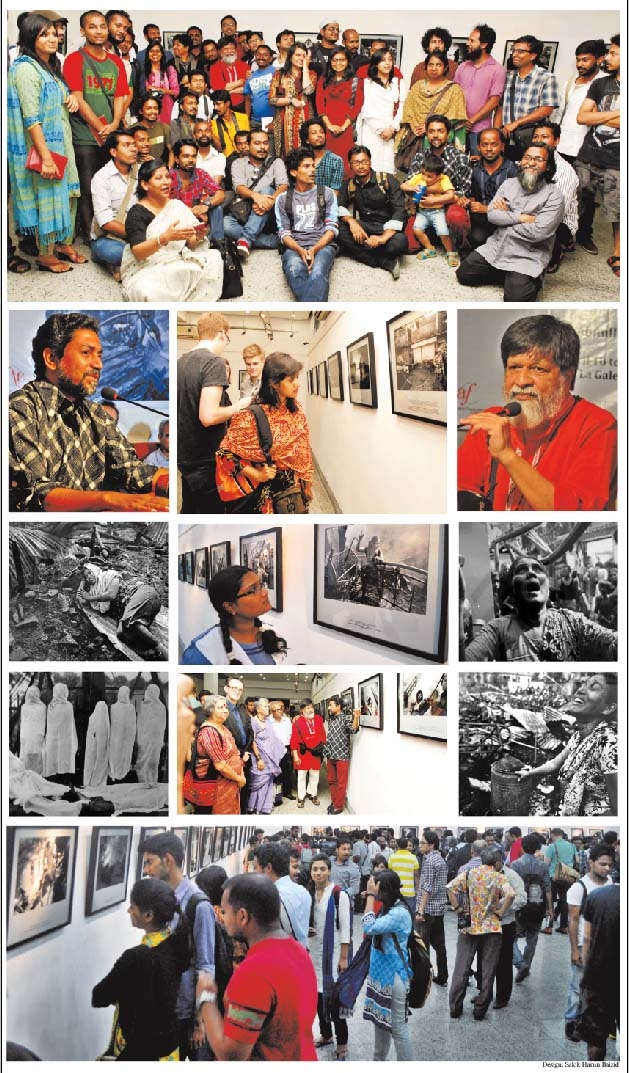
Sheikh Arif Bulbon :Fire is an ever-present death threat for the entire community of Dhaka city. From homes and workplaces to shopping malls and public spaces, a lack of building codes and fire protection have created a situation where residents are living in a continual death trap. And due to lack of training and proper rescue equipment for the fire service authority, fire accidents are responsible for the destruction of assets and homes as well as lives. The widespread lack of equipment and protection means fire deaths affect nearly everyone, from working class to middle class, and even the elites.But for poor people living in slums of Dhaka, fire creates even more havoc, among some of the capital’s most vulnerable people. Unlike their middle class neighbours, slum dwellers have no bank accounts where a lifetime’s savings are kept away or safety lockers for emergency survival after a short circuit or burning stove catches alight. A solo photography exhibition titled ‘Death Trap’ by renowned documentary photographer Abir Abdullah was held at the La Galerie of the Alliance Française de Dhaka (AFD) in the city’s Dhanmondi area recently. A total of 33 photographs of Abir Abdullah were on display in the two-week long exhibition. Khushi Kabir, Coordinator of Nijera Kori and Nurul Kabir, Editor of New Age jointly inaugurated the exhibition as guest of honours. They were accompanied by eminent photographer and Director of Drik Shahidul Alam, and Director of AFD Olivier Litvine. Abir Abdullah has been documenting the important issue of fire risks faced by residents of Dhaka for the last couple of years. Through his work, he has seen civilians risking their lives to save others in rescue operations. Fire-fighters with lack of training and proper rescue equipment are also part of the rescue operation, bringing injured and panicked victims of fire to safety. He believes his photo essay will raise awareness, and hope that it will act as a catalyst for the authorities to take prompt action to save the life and property of an entire community. He believes that it will help the policy makers and administrations to consider how Dhaka city has become the ‘second worst’ liveable city in the world. He wants to show how reversing the trend of inefficiency and neglect by the authorities can help bring an end to the needless loss of many lives in the peaceful, beautiful city of Dhaka. Abir Abdullah is a documentary photographer from Bagerhat. He has a Masters in Marketing from University of Dhaka and a Diploma in Photojournalism from Pathshala, the South Asian Media Academy. Abir photographs the people around, whose stories have moved him in some way. He has spent the last few years documenting communities in Bangladesh who have been most affected by climate change. And since 2005, Abir began documenting the dangers that plague Bangladesh’s manufacturing industry, covering a series of building collapses and fires. He has won many awards including the prestigious Mother Jones International Fund for Documentary Photography for his photo essay on Bangladeshi freedom fighters. He is also the winner of the Alexia Foundation professional grant, 2013 and won Leica prize in the Vevey International Photography Awards. Abir’s photo essays have been widely exhibited in Europe, South America, Asia and the US and his photographs have been published in the international press including New York Times, Geo, The Guardian, Der Spiegel, Time, Los Angeles Times, Washington Post, Stern and International Herald Tribune. His work has also been published in the World Press Photo book New Stories and Phaidon Press’s Blink. Currently, Abir is working in the European Press Photo Agency as the Bangladesh correspondent.

